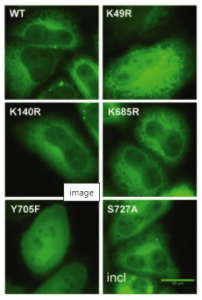
Ricardo Letra‐Vilela, Beatriz Cardoso, Catarina Silva‐Almeida, Ana Maia Rocha, Fernanda Murtinheira, Joana Branco‐Santos, Carmen Rodriguez, Vanesa Martin, Mariana Santa‐Marta, and Federico Herrera
Signal transducer and activator of transcription 3 (STAT3) is a ubiquitous and pleiotropic transcription factor that plays essential roles in normal development, immunity, response to tissue damage and cancer. We have developed a Venus‐STAT3 bimolecular fluorescence complementation assay that allows the visualization and study of STAT3 dimerization and protein‐protein interactions in living cells. Inactivating mutations on residues susceptible to post‐translational modifications (PTMs) (K49R, K140R, K685R, Y705F and S727A) changed significantly the intracellular distribution of unstimulated STAT3 dimers when the dimers were formed by STAT3 molecules that carried different mutations (ie they were “asymmetric”). Some of these asymmetric dimers changed the proliferation rate of HeLa cells. Our results indicate that asymmetric PTMs on STAT3 dimers could constitute a new level of regulation of STAT3 signaling. We put forward these observations as a working hypothesis, since confirming the existence of asymmetric STAT3 homodimers in nature is extremely difficult, and our own experimental setup has technical limitations that we discuss. However, if our hypothesis is confirmed, its conceptual implications go far beyond STAT3, and could advance our understanding and control of signaling pathways.
Doi: 10.1096/fba.2019-00049
Cited as: , , , et al. (2020) Can asymmetric post‐translational modifications regulate the behavior of STAT3 homodimers? FASEB BioAdvances 2: 116– 125; https://doi.org/10.1096/fba.2019-00049.



